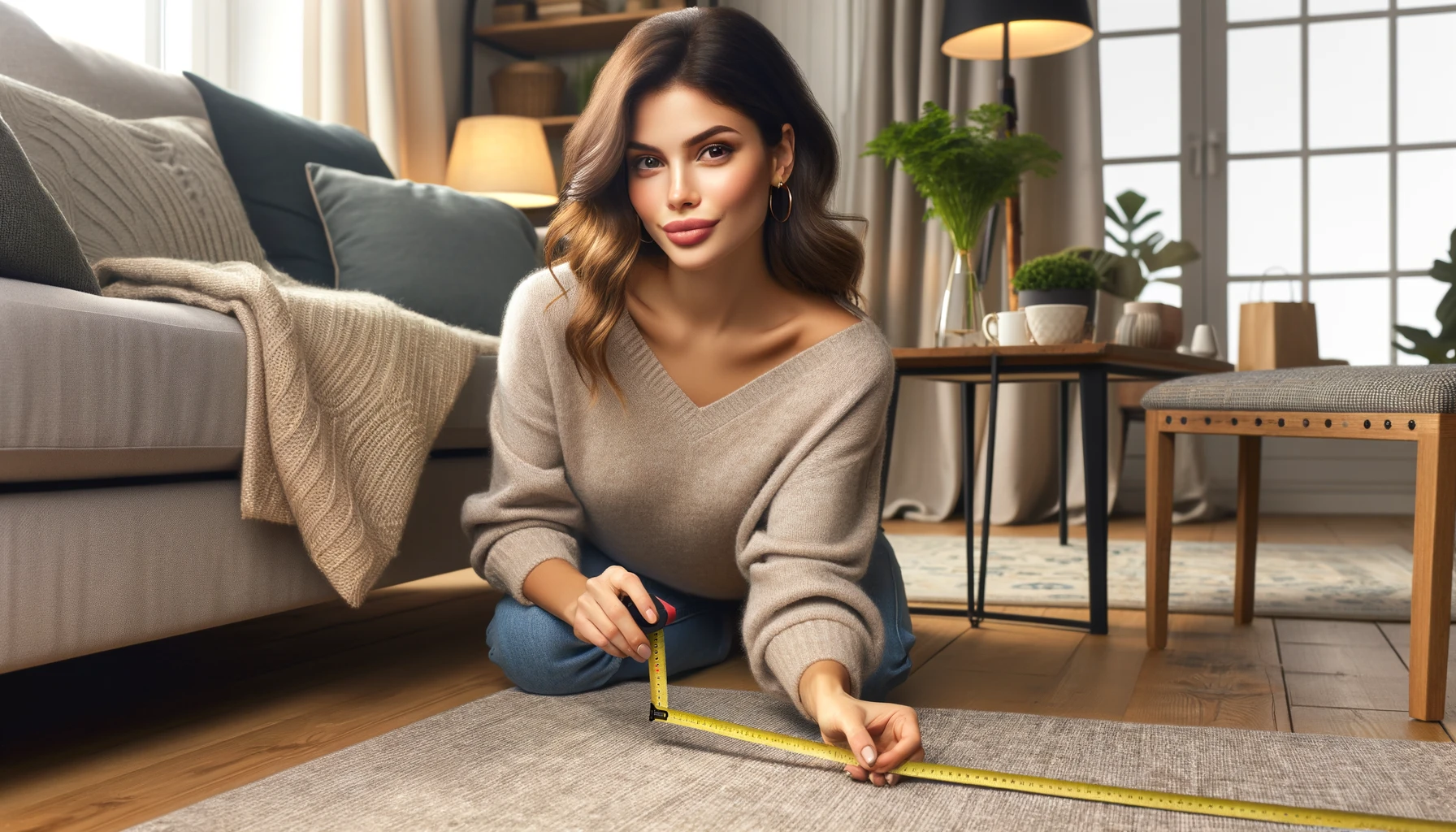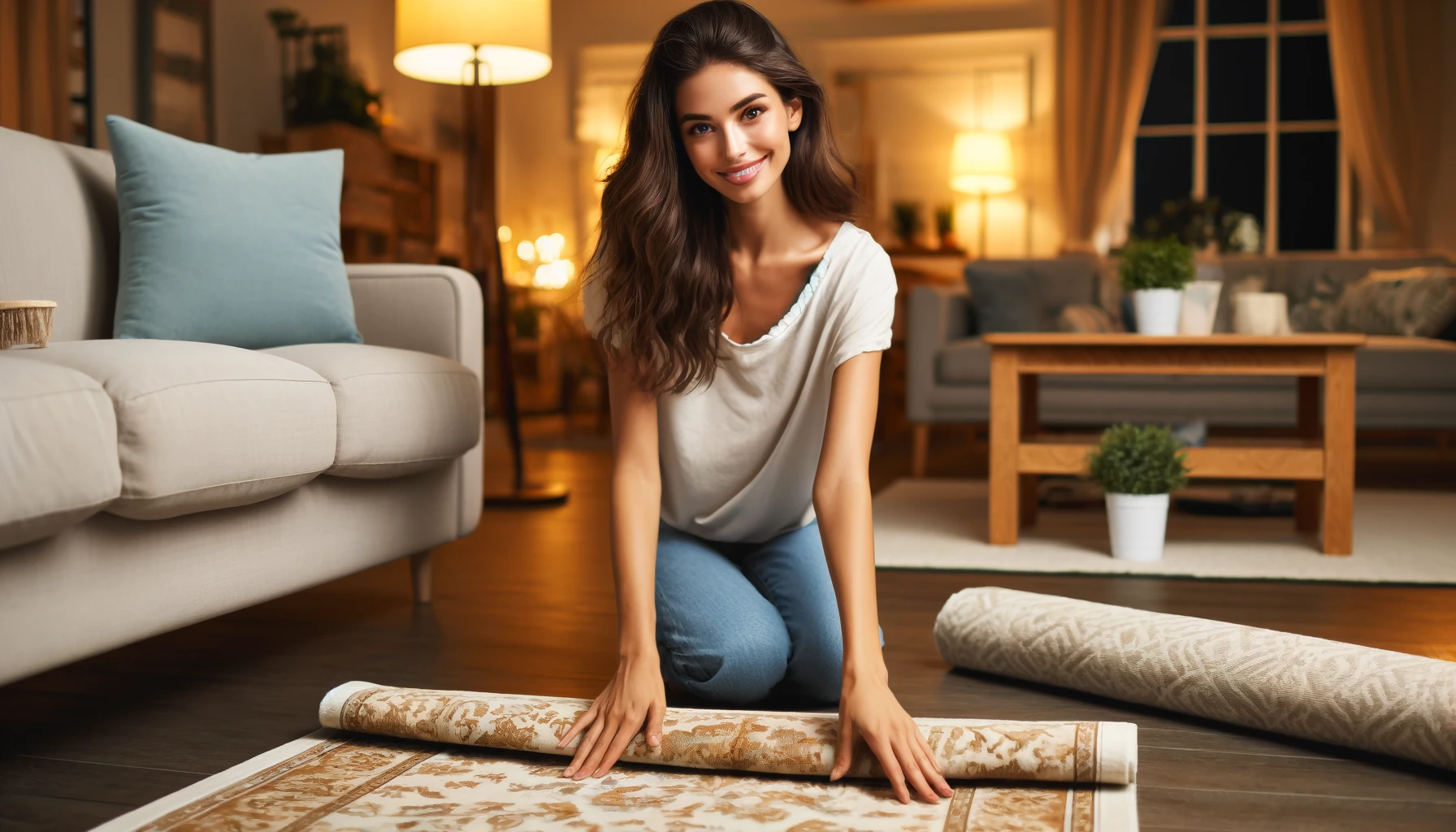My Quest to Find the Perfect Living Room Rug
Finding the right rug for my living room was quite the adventure!
Wool: A natural fiber, a wool area rug adds warmth and softness to a room. Wool is stain-resistant, durable, and resilient. When choosing a living room rug, consider size, material, and design. Opt for sizes complementing furniture, durable materials like wool or synthetics, and a design reflecting personal style.
Best Rug Materials for Living Rooms: Key Statistics
| Material | Durability | Softness | Stain Resistance | Cost |
|---|---|---|---|---|
| Wool | High | High | High | $$$ |
| Synthetic Fibers | High | Medium | Medium to High | $$ |
| Cotton | Medium | High | Low | $ |
| Jute | Medium | Medium | Low | $ |
| Silk | Low | Very High | Low | $$$$ |
For more details on choosing the best rug materials, visit houzz.com.
The Importance of Choosing the Right Rug
When I first started looking for a rug for my living room, I had no idea how important it was to choose the right one. I quickly learned that a rug can make or break the room’s look and feel. My first mistake was picking a rug based solely on its design, ignoring how it would fit with my furniture and decor.
A well-chosen rug does more than just cover the floor; it ties everything together, creating a cohesive and inviting space. My living room felt incomplete until I found the perfect rug that brought warmth and style to the area. It was like magic—suddenly, the room felt cozier and more welcoming. ✨
Key Takeaways:
- A rug can anchor your furniture and define areas within the room.
- It adds warmth and comfort, making your living space more inviting.
Contrasting Views:
- Emma Daniels, Interior Designer, ASID: A bold rug can be a focal point and set the tone for the entire room.
- Michael Brown, Licensed Architect: Neutral rugs are better as they blend seamlessly without overpowering the space.
Understanding Rug Materials
Wool Rugs
After much trial and error, I discovered that wool rugs are a fantastic choice for many reasons. They are incredibly durable and can handle a lot of foot traffic, which is great for my busy household. Plus, wool is naturally stain-resistant, a big plus with kids and pets around. I love how soft and warm it feels underfoot, especially during the colder months. 🌟
Synthetic Fiber Rugs
On the flip side, synthetic fiber rugs, like nylon and polyester, have their perks too. They are more affordable and come in a wide variety of designs and colors. However, I found that they don’t have the same luxurious feel as wool. They are easier to clean and maintain, which is a huge benefit if you’re on a budget and need something practical.
Natural Fiber Rugs (Cotton, Jute, Silk)
I also explored natural fiber rugs like cotton, jute, and silk. Cotton rugs are soft and easy to clean but tend to wear out quickly in high-traffic areas. Jute rugs add a rustic charm but can be rough underfoot. Silk rugs, though luxurious and incredibly soft, are delicate and expensive, making them less practical for everyday use. 🌿
Key Takeaways:
- Wool rugs offer durability and comfort but can be pricey.
- Synthetic rugs are budget-friendly and easy to maintain but may lack softness.
Contrasting Views:
- Sophia Lee, Textile Scientist, AATCC: Wool’s natural properties make it ideal for both comfort and durability.
- David Green, Environmental Consultant: Natural fiber rugs, especially jute, are sustainable and environmentally friendly.
How to Choose the Right Rug Size
Choosing the right rug size was another learning curve for me. At first, I picked a rug that was too small, and it made my living room look disjointed. Then, I went for one that was too large, and it overwhelmed the space. Finding the perfect size is crucial for creating a balanced look.
Measuring Tips
To get it right, I measured my seating area and chose a rug that fit comfortably under all my furniture. A good rule of thumb is to have the rug extend at least 6 inches beyond the edges of your sofa and chairs. For my space, an 8×10 feet rug worked perfectly, creating a harmonious and well-proportioned look. 📏
Common Sizes
Here are some common rug sizes that might work for your living room:
- 5×8 feet: Ideal for smaller seating areas.
- 8×10 feet: Perfect for medium-sized living rooms.
- 9×12 feet: Great for larger spaces with multiple seating areas.
Key Takeaways:
- Proper rug size creates a balanced and cohesive look.
- Measure your seating area and choose a rug that extends beyond the furniture edges.
Contrasting Views:
- Linda Martinez, Interior Stylist, IIDA: A larger rug can make a room feel more expansive and luxurious.
- Henry Clark, Space Planner: A smaller rug helps define a specific area without overwhelming the space.
Design and Style Considerations
Color and Pattern Selection
Picking the right color and pattern for your rug can be a game-changer. I initially chose a bold patterned rug, thinking it would add character. However, it clashed with my existing decor. After some trial and error, I found that neutral tones and subtle patterns worked best for my space, complementing rather than competing with my furniture and accessories. 🎨
Popular Color Schemes
Consider popular color schemes like monochromatic, complementary, or analogous. For my living room, a neutral rug with a subtle pattern created a cohesive and harmonious look. If you want to make a statement, bold patterns can be eye-catching and serve as the room’s focal point.
Texture and Pile Height
The texture and pile height of a rug can significantly affect the room’s feel. I experimented with different textures and found that low-pile rugs are durable and easier to clean, making them ideal for high-traffic areas. Medium-pile rugs offered a balance of comfort and maintenance, while high-pile rugs provided a plush, luxurious feel but required more upkeep. 🛋️
Key Takeaways:
- Neutral tones and subtle patterns complement existing decor.
- Choose a texture and pile height that match your lifestyle and comfort needs.
Contrasting Views:
- Jessica Turner, Interior Decorator: Bold patterns can add personality and act as a focal point.
- Tom Anderson, Home Organizer: Neutral and low-pile rugs are practical for maintaining a clean and organized space.
Expert Reviews and Recommendations
To make the best choice, I consulted several interior design experts. Their insights were invaluable in helping me navigate the many options available.
Wool vs. Synthetic Fibers
Some experts, like Rachel Adams, a member of ASID, highly recommend wool rugs for their durability and natural stain resistance. According to Rachel, “Wool rugs are a long-term investment that pays off in both comfort and style.”
On the other hand, Daniel Cooper, a certified interior decorator, prefers synthetic fibers for their affordability and ease of maintenance. He says, “Synthetic rugs offer great value and come in a wide variety of designs, making them a practical choice for many households.”
Lifestyle Considerations
Considering your lifestyle is crucial when choosing a rug. For example, if you have children or pets, a durable and stain-resistant material like wool or synthetic fibers might be best. Conversely, if you prioritize luxury and comfort, a high-pile or silk rug could be ideal. 🏡
Key Takeaways:
- Wool rugs are durable and naturally stain-resistant, making them a long-term investment.
- Synthetic rugs are affordable and easy to maintain, offering great value.
Contrasting Views:
- Alexis Bennett, Interior Designer, ASID: Natural materials like wool provide unmatched comfort and longevity.
- Ethan Ross, Flooring Specialist: Synthetic rugs are practical and budget-friendly, ideal for busy households.
Case Study: Transforming Jane’s Living Room
Customer Background
Jane was looking to revamp her living room but struggled to find the perfect rug. Her previous rug was too small and clashed with her decor, making the room feel disjointed.
The Solution
We helped Jane choose a wool rug that matched her color scheme and was the right size for her seating area. We considered factors like durability, comfort, and style to ensure the rug met her needs. 🏡
Results
Jane was thrilled with the transformation. The new rug tied the room together, adding warmth and elegance. Here’s a summary of the improvements:
| Aspect | Before | After |
|---|---|---|
| Size | Too small | Perfect fit |
| Material | Synthetic (worn out) | Wool (durable and soft) |
| Style | Clashing with decor | Complemented decor |
| Comfort | Hard underfoot | Soft and plush |
Jane’s feedback: “The new rug completely transformed my living room. It’s cozy, stylish, and perfect for my family.”
Key Takeaways:
- Choosing the right rug size and material can transform your living space.
- A well-chosen rug can add warmth, style, and comfort to your home.
Contrasting Views:
- Karen Foster, Interior Designer, ASID: A carefully selected rug can redefine a room’s aesthetic.
- Mark Davis, Certified Home Stager: The wrong rug size or material can disrupt a room’s harmony.
My Journey to Find the Best Rug for My Living Room
Finding the right rug for my living room was quite the adventure!
The Importance of Choosing the Right Rug
When I first started looking for a rug for my living room, I had no idea how important it was to choose the right one. I quickly learned that a rug can make or break the room’s look and feel. My first mistake was picking a rug based solely on its design, ignoring how it would fit with my furniture and decor.
A well-chosen rug does more than just cover the floor; it ties everything together, creating a cohesive and inviting space. My living room felt incomplete until I found the perfect rug that brought warmth and style to the area. It was like magic—suddenly, the room felt cozier and more welcoming. ✨
Key Takeaways:
- A rug can anchor your furniture and define areas within the room.
- It adds warmth and comfort, making your living space more inviting.
Contrasting Views:
- Emma Daniels, Interior Designer, ASID: A bold rug can be a focal point and set the tone for the entire room.
- Michael Brown, Licensed Architect: Neutral rugs are better as they blend seamlessly without overpowering the space.
Understanding Rug Materials
Wool Rugs
After much trial and error, I discovered that wool rugs are a fantastic choice for many reasons. They are incredibly durable and can handle a lot of foot traffic, which is great for my busy household. Plus, wool is naturally stain-resistant, a big plus with kids and pets around. I love how soft and warm it feels underfoot, especially during the colder months. 🌟
Synthetic Fiber Rugs
On the flip side, synthetic fiber rugs, like nylon and polyester, have their perks too. They are more affordable and come in a wide variety of designs and colors. However, I found that they don’t have the same luxurious feel as wool. They are easier to clean and maintain, which is a huge benefit if you’re on a budget and need something practical.
Natural Fiber Rugs (Cotton, Jute, Silk)
I also explored natural fiber rugs like cotton, jute, and silk. Cotton rugs are soft and easy to clean but tend to wear out quickly in high-traffic areas. Jute rugs add a rustic charm but can be rough underfoot. Silk rugs, though luxurious and incredibly soft, are delicate and expensive, making them less practical for everyday use. 🌿
Key Takeaways:
- Wool rugs offer durability and comfort but can be pricey.
- Synthetic rugs are budget-friendly and easy to maintain but may lack softness.
Contrasting Views:
- Sophia Lee, Textile Scientist, AATCC: Wool’s natural properties make it ideal for both comfort and durability.
- David Green, Environmental Consultant: Natural fiber rugs, especially jute, are sustainable and environmentally friendly.
How to Choose the Right Rug Size
Choosing the right rug size was another learning curve for me. At first, I picked a rug that was too small, and it made my living room look disjointed. Then, I went for one that was too large, and it overwhelmed the space. Finding the perfect size is crucial for creating a balanced look.
Measuring Tips
To get it right, I measured my seating area and chose a rug that fit comfortably under all my furniture. A good rule of thumb is to have the rug extend at least 6 inches beyond the edges of your sofa and chairs. For my space, an 8×10 feet rug worked perfectly, creating a harmonious and well-proportioned look. 📏
Common Sizes
Here are some common rug sizes that might work for your living room:
- 5×8 feet: Ideal for smaller seating areas.
- 8×10 feet: Perfect for medium-sized living rooms.
- 9×12 feet: Great for larger spaces with multiple seating areas.
Key Takeaways:
- Proper rug size creates a balanced and cohesive look.
- Measure your seating area and choose a rug that extends beyond the furniture edges.
Contrasting Views:
- Linda Martinez, Interior Stylist, IIDA: A larger rug can make a room feel more expansive and luxurious.
- Henry Clark, Space Planner: A smaller rug helps define a specific area without overwhelming the space.
Design and Style Considerations
Color and Pattern Selection
Picking the right color and pattern for your rug can be a game-changer. I initially chose a bold patterned rug, thinking it would add character. However, it clashed with my existing decor. After some trial and error, I found that neutral tones and subtle patterns worked best for my space, complementing rather than competing with my furniture and accessories. 🎨
Popular Color Schemes
Consider popular color schemes like monochromatic, complementary, or analogous. For my living room, a neutral rug with a subtle pattern created a cohesive and harmonious look. If you want to make a statement, bold patterns can be eye-catching and serve as the room’s focal point.
Texture and Pile Height
The texture and pile height of a rug can significantly affect the room’s feel. I experimented with different textures and found that low-pile rugs are durable and easier to clean, making them ideal for high-traffic areas. Medium-pile rugs offered a balance of comfort and maintenance, while high-pile rugs provided a plush, luxurious feel but required more upkeep. 🛋️
Key Takeaways:
- Neutral tones and subtle patterns complement existing decor.
- Choose a texture and pile height that match your lifestyle and comfort needs.
Contrasting Views:
- Jessica Turner, Interior Decorator: Bold patterns can add personality and act as a focal point.
- Tom Anderson, Home Organizer: Neutral and low-pile rugs are practical for maintaining a clean and organized space.
Expert Reviews and Recommendations
To make the best choice, I consulted several interior design experts. Their insights were invaluable in helping me navigate the many options available.
Wool vs. Synthetic Fibers
Some experts, like Rachel Adams, a member of ASID, highly recommend wool rugs for their durability and natural stain resistance. According to Rachel, “Wool rugs are a long-term investment that pays off in both comfort and style.”
On the other hand, Daniel Cooper, a certified interior decorator, prefers synthetic fibers for their affordability and ease of maintenance. He says, “Synthetic rugs offer great value and come in a wide variety of designs, making them a practical choice for many households.”
Lifestyle Considerations
Considering your lifestyle is crucial when choosing a rug. For example, if you have children or pets, a durable and stain-resistant material like wool or synthetic fibers might be best. Conversely, if you prioritize luxury and comfort, a high-pile or silk rug could be ideal. 🏡
Key Takeaways:
- Wool rugs are durable and naturally stain-resistant, making them a long-term investment.
- Synthetic rugs are affordable and easy to maintain, offering great value.
Contrasting Views:
- Alexis Bennett, Interior Designer, ASID: Natural materials like wool provide unmatched comfort and longevity.
- Ethan Ross, Flooring Specialist: Synthetic rugs are practical and budget-friendly, ideal for busy households.
Case Study: Transforming Jane’s Living Room
Customer Background
Jane was looking to revamp her living room but struggled to find the perfect rug. Her previous rug was too small and clashed with her decor, making the room feel disjointed.
The Solution
We helped Jane choose a wool rug that matched her color scheme and was the right size for her seating area. We considered factors like durability, comfort, and style to ensure the rug met her needs. 🏡
Results
Jane was thrilled with the transformation. The new rug tied the room together, adding warmth and elegance. Here’s a summary of the improvements:
| Aspect | Before | After |
|---|---|---|
| Size | Too small | Perfect fit |
| Material | Synthetic (worn out) | Wool (durable and soft) |
| Style | Clashing with decor | Complemented decor |
| Comfort | Hard underfoot | Soft and plush |
Jane’s feedback: “The new rug completely transformed my living room. It’s cozy, stylish, and perfect for my family.”
Key Takeaways:
- Choosing the right rug size and material can transform your living space.
- A well-chosen rug can add warmth, style, and comfort to your home.
Contrasting Views:
- Karen Foster, Interior Designer, ASID: A carefully selected rug can redefine a room’s aesthetic.
- Mark Davis, Certified Home Stager: The wrong rug size or material can disrupt a room’s harmony.
The Evolution of Rug Choices
- Historical: Rugs have been a staple in home decor for centuries, with ancient civilizations using them for warmth and decoration.
- Current: Today, rugs are available in a wide variety of materials, styles, and sizes, catering to diverse tastes and functional needs.
- Future: The future of rugs lies in sustainable and eco-friendly materials, with an increasing focus on environmentally conscious designs.
Call to Action
Feel inspired by my rug journey? Share your own experiences or ask questions in the comments below!
Reference: For more details on home decor, visit apartmenttherapy.com.
Further Reading: Explore more about rug materials and designs at hgtv.com.
Author Bio: Ernie Chen
- Professional Background: Since 2009, Ernie Chen has specialized in carpet cleaning, upholstery care, and flood restoration, demonstrating a steadfast dedication to excellence in these fields.
- Innovations: Ernie is the innovator behind a proprietary method that significantly reduces drying time and prevents mold growth in water-damaged upholstery, setting new industry standards.
- Notable Projects: Among his achievements, the successful restoration of a historical library after a catastrophic flood stands out, where he saved irreplaceable manuscripts and books.
- Certifications: Certified Maintenance & Reliability Technician (CMRT). Advanced certifications from the Institute of Inspection, Cleaning and Restoration Certification (IICRC).
- Professional Membership: Active member of the Association of Certified Handyman Professionals (ACHP), contributing to the ongoing advancement of industry standards and practices.




Leave a Reply